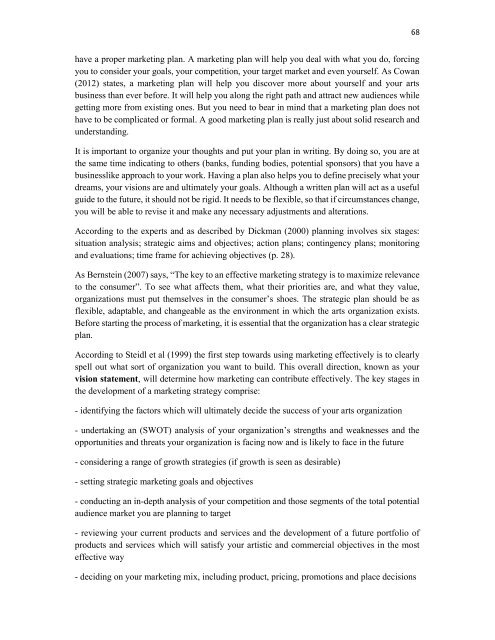and Music
Omega-Book
Omega-Book
You also want an ePaper? Increase the reach of your titles
YUMPU automatically turns print PDFs into web optimized ePapers that Google loves.
68<br />
have a proper marketing plan. A marketing plan will help you deal with what you do, forcing<br />
you to consider your goals, your competition, your target market <strong>and</strong> even yourself. As Cowan<br />
(2012) states, a marketing plan will help you discover more about yourself <strong>and</strong> your arts<br />
business than ever before. It will help you along the right path <strong>and</strong> attract new audiences while<br />
getting more from existing ones. But you need to bear in mind that a marketing plan does not<br />
have to be complicated or formal. A good marketing plan is really just about solid research <strong>and</strong><br />
underst<strong>and</strong>ing.<br />
It is important to organize your thoughts <strong>and</strong> put your plan in writing. By doing so, you are at<br />
the same time indicating to others (banks, funding bodies, potential sponsors) that you have a<br />
businesslike approach to your work. Having a plan also helps you to define precisely what your<br />
dreams, your visions are <strong>and</strong> ultimately your goals. Although a written plan will act as a useful<br />
guide to the future, it should not be rigid. It needs to be flexible, so that if circumstances change,<br />
you will be able to revise it <strong>and</strong> make any necessary adjustments <strong>and</strong> alterations.<br />
According to the experts <strong>and</strong> as described by Dickman (2000) planning involves six stages:<br />
situation analysis; strategic aims <strong>and</strong> objectives; action plans; contingency plans; monitoring<br />
<strong>and</strong> evaluations; time frame for achieving objectives (p. 28).<br />
As Bernstein (2007) says, “The key to an effective marketing strategy is to maximize relevance<br />
to the consumer”. To see what affects them, what their priorities are, <strong>and</strong> what they value,<br />
organizations must put themselves in the consumer’s shoes. The strategic plan should be as<br />
flexible, adaptable, <strong>and</strong> changeable as the environment in which the arts organization exists.<br />
Before starting the process of marketing, it is essential that the organization has a clear strategic<br />
plan.<br />
According to Steidl et al (1999) the first step towards using marketing effectively is to clearly<br />
spell out what sort of organization you want to build. This overall direction, known as your<br />
vision statement, will determine how marketing can contribute effectively. The key stages in<br />
the development of a marketing strategy comprise:<br />
- identifying the factors which will ultimately decide the success of your arts organization<br />
- undertaking an (SWOT) analysis of your organization’s strengths <strong>and</strong> weaknesses <strong>and</strong> the<br />
opportunities <strong>and</strong> threats your organization is facing now <strong>and</strong> is likely to face in the future<br />
- considering a range of growth strategies (if growth is seen as desirable)<br />
- setting strategic marketing goals <strong>and</strong> objectives<br />
- conducting an in-depth analysis of your competition <strong>and</strong> those segments of the total potential<br />
audience market you are planning to target<br />
- reviewing your current products <strong>and</strong> services <strong>and</strong> the development of a future portfolio of<br />
products <strong>and</strong> services which will satisfy your artistic <strong>and</strong> commercial objectives in the most<br />
effective way<br />
- deciding on your marketing mix, including product, pricing, promotions <strong>and</strong> place decisions


